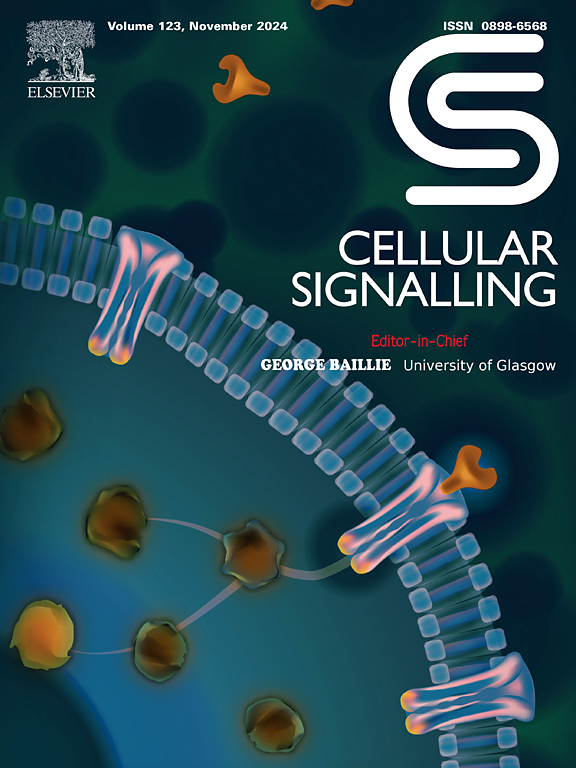CALB2 facilitates macrophage M2 polarization to promote the growth and metastasis of pancreatic adenocarcinoma
IF 4.4
2区 生物学
Q2 CELL BIOLOGY
引用次数: 0
Abstract
Tumor-associated macrophages mainly differentiate into M2 phenotypes, which secrete cytokines that reshape the tumor microenvironment and promote tumor progression. This study was to explore the mechanism of CALB2 in M2 polarization and pancreatic adenocarcinoma (PAAD). Clinical tissue samples of PAAD were collected, followed by detection of WTAP, FOSL1, and CALB2 expression. The correlation between WTAP and FOSL1 or between FOSL1 and CALB2 was analyzed. THP1 cells were induced into M0 macrophages, followed by plasmid transfection and induction of M2-type macrophages. After macrophages were co-cultured with PAAD cells, functional experiments were designed to evaluate PAAD cell malignant behaviors. A transplantation tumor model and a liver metastasis model were established to assess tumor growth and metastasis. High expression of WTAP, FOSL1, and CALB2 was found in PAAD tissues and M2-type macrophages. WTAP positively linked with FOSL1, so as FOSL1 and CALB2. Mechanistically, WTAP enhanced m6A modification of FOSL1 to promote its expression, and FOSL1 promoted CALB2 transcription. Knockdown of WTAP, FOSL1, or CALB2 in macrophages inhibited PAAD cell malignant behaviors, which could be reversed by CALB2 upregulation. WTAP knockdown restrained the growth and metastasis of PAAD in nude mice via the FOSL1/CALB2 axis. In conclusion, WTAP increased the m6A level of FOSL1, activated CALB2 transcription, and promoted M2 polarization of macrophages, thereby promoting the growth and metastasis of PAAD.
CALB2促进巨噬细胞M2极化,促进胰腺腺癌生长和转移
肿瘤相关巨噬细胞主要分化为M2型,分泌重塑肿瘤微环境、促进肿瘤进展的细胞因子。本研究旨在探讨CALB2在M2极化和胰腺腺癌(PAAD)中的作用机制。收集PAAD临床组织标本,检测WTAP、FOSL1、CALB2的表达。分析WTAP与FOSL1或FOSL1与CALB2的相关性。将THP1细胞诱导为M0型巨噬细胞,转染质粒,诱导为m2型巨噬细胞。将巨噬细胞与PAAD细胞共培养后,设计功能实验评价PAAD细胞的恶性行为。建立移植瘤模型和肝转移模型,评估肿瘤生长和转移情况。WTAP、FOSL1、CALB2在PAAD组织和m2型巨噬细胞中高表达。WTAP与FOSL1正相关,FOSL1与CALB2也正相关。机制上,WTAP增强m6A修饰FOSL1促进其表达,而FOSL1促进CALB2转录。巨噬细胞中WTAP、FOSL1或CALB2的下调可抑制PAAD细胞的恶性行为,并可通过上调CALB2来逆转。WTAP敲低通过FOSL1/CALB2轴抑制裸鼠PAAD的生长和转移。综上所述,WTAP可提高FOSL1的m6A水平,激活CALB2转录,促进巨噬细胞M2极化,从而促进PAAD的生长和转移。
本文章由计算机程序翻译,如有差异,请以英文原文为准。
求助全文
约1分钟内获得全文
求助全文
来源期刊

Cellular signalling
生物-细胞生物学
CiteScore
8.40
自引率
0.00%
发文量
250
审稿时长
27 days
期刊介绍:
Cellular Signalling publishes original research describing fundamental and clinical findings on the mechanisms, actions and structural components of cellular signalling systems in vitro and in vivo.
Cellular Signalling aims at full length research papers defining signalling systems ranging from microorganisms to cells, tissues and higher organisms.
 求助内容:
求助内容: 应助结果提醒方式:
应助结果提醒方式:


